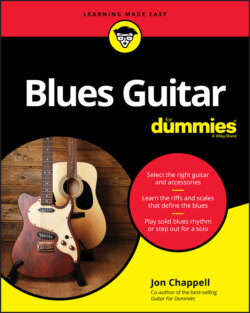Читать книгу Blues Guitar For Dummies - Jon Chappell - Страница 40
Dissecting an Acoustic and an Electric
ОглавлениеAnatomically speaking, guitars come in two sexes: acoustic and electric. Since solidbody electric guitars do not make sound acoustically, but through electronics, they have more chromosomes — er, components — than do acoustics. Some of the functions of these gizmos aren’t even obvious until you plug in and start messing around with them. So electric guitars may seem more complicated at first, but really, you learn very quickly what all the stuff does, and it’s more about technique than anything else.
It’s true, though, that about the only thing that can go wrong with an acoustic is that a string breaks. On an electric, there are more moving and electronic parts that are subject to failure, so you have a little more to keep track of on an electric. And all guitars, being made of wood and moving parts, can go out of whack and need periodic adjustment to keep them humming and happy.
Even though electric guitars are more complicated from a technological standpoint, making an acoustic guitar is harder than making an electric guitar. That’s why, pound for pound, a quality acoustic guitar will cost just as much or more than its electric counterpart.
But both types follow the same basic approach to neck function and string tension. That’s why acoustic and electric guitars have very similar constructions, despite a sometimes radical difference in tone production. Figures 2-3 and 2-4 show the various parts of an electric guitar and an acoustic guitar.
FIGURE 2-3: A typical acoustic guitar with its major parts labeled.
The following list tells you the functions of the primary parts of a guitar:
Back (acoustic only): The part of the body that holds the sides in place; made of two or three pieces of wood.FIGURE 2-4: A typical electric guitar with its major parts labeled.
Bar (electric only): A metal rod attached to the bridge that varies the string tension by tilting the bridge back and forth. Also called the tremolo bar, whammy bar, vibrato bar, and wang bar.
Body: The box that provides an anchor for the neck and bridge and creates the playing support for the right hand. On an acoustic, the body includes the amplifying sound chamber that produces the guitar’s tone. On an electric, it consists of the housing for the bridge assembly and electronics (pickups as well as tone and volume controls).
Bridge: The metal (electric) or wooden (acoustic) plate that anchors the strings to the body.
End pin: A metal post where the rear end of the strap connects. On acoustic-electrics (acoustic guitars with built-in pickups and electronics), the pin often doubles as the output jack where you plug in.
Fingerboard: A flat, planklike piece of wood that sits atop the neck, where you place your left-hand fingers to create pitches and chords. The fingerboard is also known as the fretboard, because the frets are embedded in it.
Frets: 1) Thin metal wires or bars running perpendicular to the strings that shorten the effective vibrating length of a string, enabling it to produce different pitches. 2) A verb describing worry, as in “He frets about how he’ll ever recover his lost mojo.”
Headstock: The section that holds the tuning machines and provides a place for the manufacturer to display its logo. Not to be confused with “Woodstock,” the section of New York that provided a place for the ’60s generation to display its music.
Neck: The long, clublike wooden piece that connects the headstock to the body.
Nut: A grooved sliver of stiff nylon or other synthetic substance that stops the strings from vibrating beyond the fingerboard. The strings pass through the grooves on their way to the tuners in the headstock. The nut is one of the two points at which the vibrating area of the string ends. (The other is the bridge.)
Output jack (electric only): The insertion point for the cord that connects the guitar to an amplifier or other electronic device.
Pickup selector (electric only): A switch that determines which pickups are currently active.
Pickups (electric only): Barlike magnets that create the electrical current, which the amplifier converts into musical sound.
Sides (acoustic only): Separate curved wooden pieces on the body that join the top to the back.
Strap pin: Metal post where the front, or top, end of the strap connects. (Not all acoustics have a strap pin. If the guitar is missing one, tie the top of the strap around the headstock.)
Strings: The six metal (for electric and steel-string acoustic guitars) or nylon (for classical guitars) wires that, drawn taut, produce the notes of the guitar. Although not strictly part of the actual guitar (you attach and remove them at will on top of the guitar), strings are an integral part of the whole system, and a guitar’s entire design and structure revolves around making the strings ring out with a joyful noise. (See Chapter 16 for more information on changing strings.)
Top: The face of the guitar. On an acoustic, this piece is also the sounding board, which produces almost all the guitar’s acoustic qualities. On an electric, the top is primarily a cosmetic or decorative cap that overlays the rest of the body material.
Tuning machines: Geared mechanisms that raise and lower the tension of the strings, drawing them to different pitches. The string wraps tightly around a post that sticks out through the top, or face, of the headstock. The post passes through to the back of the headstock, where gears connect it to a tuning key. Also known as tuners, tuning pegs, tuning keys, and tuning gears.
Volume and tone controls (electric only): Knobs that vary the loudness of the guitar’s sound and its bass and treble emphasis.
